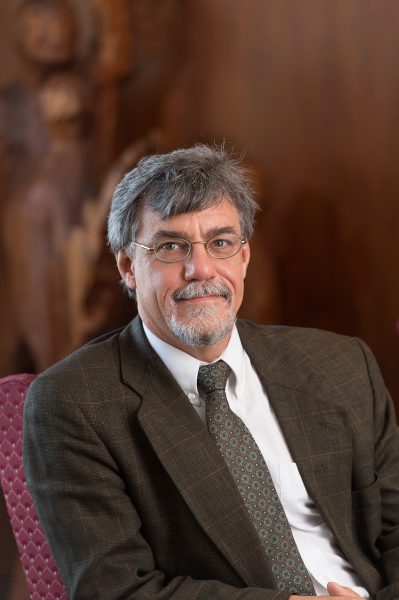Pictured above: Photos of the Old English Hexateuch, the earliest copy of part of the Old Testament in English
For many of us, college is an opportunity to explore and discover new subjects, new viewpoints, and new ways of knowing. Some times, we find ourselves engaged in a subject that becomes our not only our focus for four years, but a launching point for our lives.
In the early 1980s, Ben Withers was a college student at a small liberal arts college in rural Minnesota taking a variety of general education courses, including art history. The class was his first exposure to the historical and cultural context of the art world, and at the end of the semester, the professor took the art history class to the Minneapolis Institute of Art. It was the first time Withers had stepped into a museum, and it transformed him. “We could discuss a piece of art, date it, put it into a historical context, and compare it with other pieces. It was so much fun,” he says. The formal analysis of art history – understanding how a piece was created, what materials were used, and where they came from, as well as the cultural context in which a piece was created, the history, the people, the place – inspired not only Wither’s undergraduate major, but a career and a lifetime of learning.
Withers focused his research on illustrated medieval manuscripts, in particular, The Old English Illustrated Hexateuch, also called Cotton MS Claudius B.iv. This manuscript, now in the British Library, dates from 11th century England, and contains a prose translation of the Bible’s Old Testament books of Genesis, Exodus, Leviticus, Numbers, Deuteronomy, and Joshua, with nearly 400 illustrations.
“The theory is that this book was a way of helping people understand the Old Testament as well as a way to learn Old English,” says Withers. “It is not of high artistic quality, and it’s written in Old English rather than Latin, so we can extrapolate that it was intended for a lay audience: someone new to the monastery or for an aristocrat.” The manuscript became the subject of Withers’ 2007 book The Illustrated Old English Hexateuch, Cotton Cladius B.iv: The Frontier of Seeing and Reading in Anglo-Saxon England.
Beyond his career as an art historian, Withers has been a professor of art history, a department chair, an honors program director, and an associate provost. Now nearing the end of his second year as dean of the College of Liberal Arts at CSU, Withers continues to apply the skills of art historian to his professional life: he spends a great deal of his time listening. Listening to faculty explain their research, listening to students share interests, ideas, and plans for the future, and listening to the national conversation about the liberal arts.

Listening is a crucial part of being a scholar of the past and a strategic thinker of the future. “History is learning to listen to distant voices, voices of people who are no longer present to speak for themselves. What ‘speaks’ for them are the paintings, the objects, the literature, the mundane documents and artifacts left behind. To understand those in the past we have to listen and learn to ask questions appropriate to that context,” he says.
It is the listening, the asking, and the desire to understand that drives much of the research, scholarship, and creative artistry found in the College of Liberal Arts. With disciplines ranging from art to anthropology and journalism to women’s studies, the liberal arts of today’s educational system seeks to engage in its historic intention to teach skills that allow people to function successfully as free citizens.
'Liberal Arts' Defined
Liberal comes from the Latin liberalis – meaning free (rather than imprisoned or subjugated)
Arts comes from the Latin root ars, art - meaning “art, skill”
Note: There are three different groupings of arts:
- artes mechanicae (mechanical or servile arts),
- artes liberals (liberal arts),
- The Arts (fine and performing arts)
Before we became a university in 1957, CSU was named Colorado A&M: Colorado Agricultural and Mechanical College.
According to the American Association of Colleges and Universities, “a liberal education is an approach to learning that empowers individuals and prepares them to deal with complexity, diversity, and change. It provides students with broad knowledge of the wider world (e.g. science, culture, and society) as well as in-depth study in a specific area of interest.
“A liberal education helps students develop a sense of social responsibility, as well as strong and transferable intellectual and practical skills such as communication, analytical and problem-solving skills, and a demonstrated ability to apply knowledge and skills in real-world settings.”
At CSU, this liberal education is approached through the areas of learning, scholarship, and engagement. “The liberal arts aren’t just a field of study. The liberal arts are a living thing, a thread that connects us all,” says Withers. “We are all learners, who share a curiosity for our world that connects across disciplines and reflects our dynamic, diverse, and multiple interests. We are all scholars, exploring the intersections among teaching, scholarship, and research. We are meaningfully engaged in our communities, moved by knowledge and empathy to put our education into action.”
The ways in which the liberal arts produce and share new knowledge or creative artistry is how we put our education into action to advance the human experience. Whether it’s an analysis of the text and illustrations from an 11th century religious manuscript, an exploration of the barriers to education for young women in Nepal, or a hands-on learning lab for music teachers, a liberal arts education provides students with the skills and empathy to be good global citizens, productive and ethical workers, and strong leaders, skills that empower people to function successfully as free citizens.
We invite you to explore the many different ways – and many different topics – we engage in research and creative artistry at CSU.
